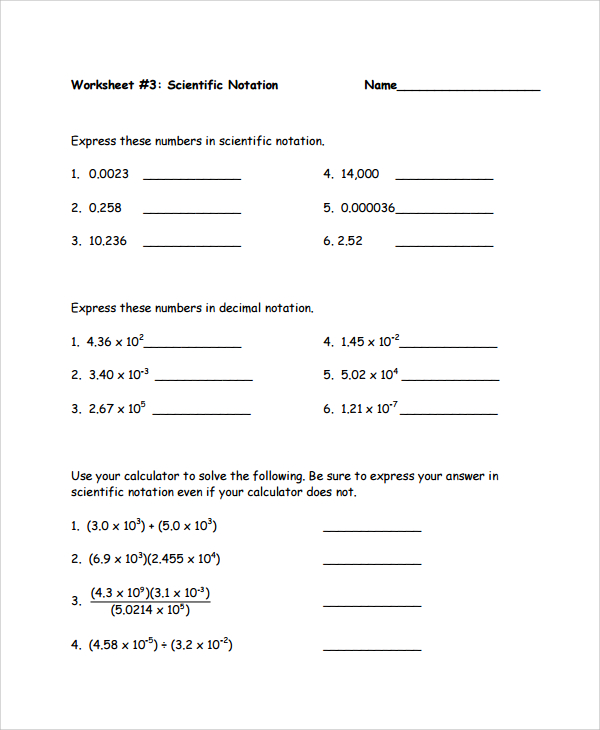
In this case you would hit the 2nd key and THEN the key with the EE above it to enter an exponent. In other words, if your calculator has the symbol EE above a key in yellow, then there is probably a yellow key that says 2nd. If the EE or EEX or EXP is not on the button itself (it may be above the button in another color), you will need to hit an extra key to use it. These are used generally the only abbreviations used by manufacturers.

What you are looking for is a button that has one of the following abbrieviations: EE, EEX, or EXP. Unfortunately, not all calculators have these buttons in the same place. Finding the KeysĪll scientific calculators have an exponent button and you must know where it is in order to use your calculator properly in chemistry.
#SCIENTIFIC NOTATION CHEMISTRY CALCULATOR HOW TO#
(9.When doing scientific notation work on your calculator, you must first find the appropriate keys on your calculator, you must understand what your calculator is saying when it uses scientific notation and you must know how to enter problems on your calculator.Express the final answer in proper scientific notation. Use your calculator to evaluate these expressions.Write these numbers in scientific notation by counting the number of places the decimal point is moved.Rewrite them so that they are in proper scientific notation. These numbers are not written in proper scientific notation.Express these numbers in standard notation.Express these numbers in scientific notation.If in doubt, consult your instructor immediately. Different models of calculators require different actions for properly entering scientific notation. Be sure you know how to correctly enter a number in scientific notation into your calculator. When performing calculations, you may have to enter a number in scientific notation into a calculator. Many quantities in chemistry are expressed in scientific notation.

This number is positive if you move the decimal point to the right and negative if you move the decimal point to the left. The number of places equals the power of 10. In scientific notation, the number is written as 5.59 × 10 −7.Īnother way to determine the power of 10 in scientific notation is to count the number of places you need to move the decimal point to get a numerical value between 1 and 10. Note that we omit the zeros at the end of the original number. In scientific notation, the number is written as 2.76 × 10 6. In scientific notation, the number is 8.84 × 10 −3. In scientific notation, the number is 3.06 × 10 5. Typically, the extra zero digits at the end or the beginning of a number are not included.Įxpress these numbers in scientific notation. For small numbers, the same process is used, but the exponent for the power of 10 is negative: Thus, the number in scientific notation is 7.9345 × 10 4. For example, to write 79,345 in scientific notation, Then determine the power of 10 needed to make that number into the original number and multiply the written number by the proper power of 10.

The part of a number in scientific notation that is multiplied by a power of 10 is called the coefficient. A negative exponent implies a decimal number less than one.Ī number is expressed in scientific notation by writing the first nonzero digit, then a decimal point, and then the rest of the digits. Again, the value of the exponent is equal to the number of zeros in the denominator of the associated fraction. Small numbers can also be expressed in scientific notation but with negative exponents: Table 2.2 Powers of Negative 10 10 −1Īnd so forth. (Scientific notation is sometimes called exponential notation.) The exponent’s value is equal to the number of zeros in the number expressed in standard notation. The raised number to the right of the 10 indicating the number of factors of 10 in the original number is the exponent. Powers of 10 are used to express numbers that have many zeros: Table 2.1 Powers of 10 10 0Īnd so forth. Scientific notation is an expression of a number using powers of 10. However, for very large numbers, such as 306,000,000, or for very small numbers, such as 0.000000419, standard notation can be cumbersome because of the number of zeros needed to place nonzero numbers in the proper position. For relatively small numbers, standard notation is fine. Numbers such as 17, 101.5, and 0.00446 are expressed in standard notation. Standard notation is the straightforward expression of a number. The number tells “how many.” It is important to be able to express numbers properly so that the quantities can be communicated properly. Quantities have two parts: the number and the unit.


 0 kommentar(er)
0 kommentar(er)
